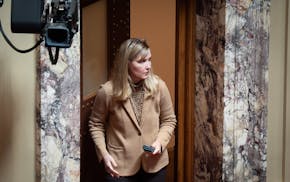More police departments across the metro suburbs are considering equipping their officers with body cameras in an effort to improve accountability and transparency.
Burnsville police became the first in Minnesota to use body-worn cameras in 2010, about the time that many departments around the country began adopting the cameras partly as a response to public outrage over excessive use of force by officers.
Now Robbinsdale, St. Louis Park and Savage are among local suburbs that recently are either looking into policies on how the cameras would be used or actively moving to deploy them.
Robbinsdale officials are expected to authorize the purchase of cameras in June and begin using them by early fall, according to police Sgt. Ryan Seibert. Twelve cameras and updates on the department's vehicle recording systems will cost about $62,000, he said.
"The overall rationale is quite clear," Seibert said. "It does increase transparency between the police and the community."
The use of body-worn cameras and their data are regulated by state law. Many of the policies for suburban departments list proper collection of evidence, increased police accountability and improving public trust as the main reasons for using cameras.
The Robbinsdale City Council approved a body-camera policy in early May. Under the policy, officers must use the cameras on all calls, whether arrests, interrogations or any interaction "that becomes or is anticipated to be adversarial."
"The police are going to say, 'See, I told you so!' " Council Member Bill Blonigan said at a council meeting last month. "And then other times, if an officer is thinking of maybe doing something wrong, they would be like, 'Oh, I better not do that. This is on camera.' "
St. Louis Park officials began work on a body-camera policy at the beginning of the year, Police Chief Mike Harcey said. He expects a draft to be ready by the end of July and for the city to gather more public feedback in August.
Harcey said some city staffers and leaders are asking whether the cost of the cameras can be justified.
"Our department has developed trust within our community," he said. "There's some question of whether or not we even need to have a body-worn camera program."
But Harcey said that the cameras help keep officers accountable for their acts, and also serve as an effective way to collect evidence. Besides, he said, they are becoming the norm for all departments.
If St. Louis Park officials approve the policy, police will begin using the cameras by January, according to city documents.
Bloomington police released a draft of its policy in late April. While on the job, uniformed officers would activate their cameras during all interactions "to the extent practical without compromising safety," according to the draft.
Savage police are hoping to equip some officers with cameras by the end of the year, and other cities are updating their body-worn camera policies.
Richfield officials set the city's policy in 2014 and plan to update it this month. All officers could be using cameras by 2020 or 2021, according to a news release.
Meanwhile, in Minneapolis, Mayor Jacob Frey and Chief Medaria Arradondo announced an overhaul of the city's policy in April.
"For the first time, we're going to give it teeth," Frey said, referring to an audit that found officers frequently failed to turn on their cameras when going to calls.
State law requires police departments to go through an independent audit of their procedures every other year.
Miguel Otárola • 612-673-4753

Meet the affordable housing champion fighting for St. Paul's West Side

Minnesota Senate panel convenes ethics hearing into Sen. Mitchell's burglary arrest
St. Paul police: officers shoot, kill woman who pointed gun at them after suicide call

Witnesses in Feeding Our Future trial testify they saw no meals served

